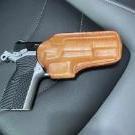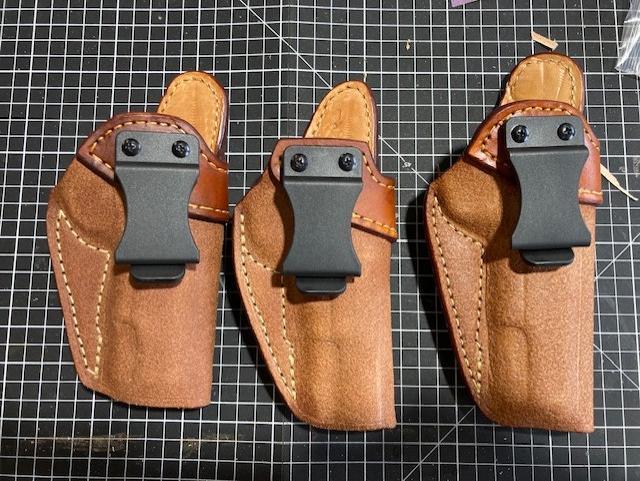All Activity
- Past hour
-
Not really unless you dump the clutch like in a standard transmission truck. kgg
- Today
-
😄New word learnt. Couldn't pass up the opportunity to use it!
-
I'm still new to leatherworking. I have made about a dozen holsters, a few knife scabbards, and quite a few belts. I currently have a flatbed sewing machine, a Seiko CW8 Cylinder Arm Machine, and Weaver Cub, and hoping to acquire a Class 4 machine when practical. My question is regarding the Landis 5 in 1. Are these machines particularly useful in the realm of holster and scabbard building? A friend of mine is a retired boot repair shop owner and once told me how much he used the presser wheel which was good when gluing layered edges and I can see that in the boot resoling application but would that part of the 5 in 1 have any benefit with holsters and scabbards? I can see where the cutting wheel could make cleaner edges before beveling and finishing. 500 to 700 is a pretty substantial investment for me and I don't mind IF it's something I will use frequently. Thanks in advance.
-
Ashley’s Book of Knots contains brief instructions on how to tie this. See plates 1705 and 1706 on page 294. (For some reason, I could not paste a link, but search Ashley’s Book of Knots PDF for a free online copy.) I first saw this knot back in the 1970s when a leather worker named Rob McCall (one of the most creative, inspired & inspiring leatherworkers I’ve met) used it to attach the buckle to his belts and simultaneously form a triple keeper. He also used it as an adjuster on his handbag straps. If you see a leather piece signed Sparrow, it’s one of his.
-
I really love the old Harleys, Would love to have an old 1947 Knuckle Head. I told my good friends this old 1951 Landis 16 is my Knuckle Head lol.
-
Yes it did on the larger leather pieces it works out nice. The tote bags I use a 5 to 6oz and the leather that is soft or milled and this helps out. Its a game changer with this machine..
-
I might have some spare screws. Based in Germany. Actually your 105 has been rebuild to a 105-6 standart to work with a roller feet, does the presser feet rod have a flat and bolt hole? I might have also some feet.
-
I had look yon up
-
I wish. I gotta hang about in case anything else needs moving
-
I haven't done many roughout holsters; there's definitely a knack to keeping the look clean and consistent. Larry
-
I love those belts! That is fantastic work! I really like he edge trim and stitching contrast.
-
Tall Post Sewing Machines?
RockyAussie replied to Cumberland Highpower's topic in Leather Sewing Machines
This following link shows the tall post machine I have. Note that the max thread size is 138. The needle goes into the right side which is good for allowing wide products that can be held out in the open left side if that makes sense. -
On the other-other hand, these digital servos suffer from low torque at low speeds. With enough reduction we can run the motor a little faster, where it might be a little happier and still have decent torque. If the machine will stand up to the torque of a clutch motor at 1700 rpm to 3400 rpm, I doubt even a torque increased servo is going to damage them. Now I need to go find out the torque put out by those old clutch motors. EDIT: So the rated torque of the clutch is about the same as the servo (which makes sense). But the giant spinning mass of that clutch motor has got to pack a pretty healthy wallop.
-
I've somewhat decided that I'd like a new machine, one kind of new to me anyway. A tall post. I've used a couple more standard post bed machines, and to be honest I prefer them over most any type. I've never used a "tall" or "extra tall" version. All I've seen have the bobbin/hook offset to the left as opposed to the right of the post. I'm wondering why that is? So far I've only seen Chinese machines for sale, I wonder if there are any good used machines that are EU/Japanese made? I'd like to run 138, but could go as high as 207 on top at times. Any recommendations?
-
What are y'all using to limit torque to your machines? So far all I've got is a loose belt.
-
My Take: Speed reduction is like a double edged sword. If you use a speed reducer for just reducing the machines sewing speed no harm will come to your machines internals. If you want / need the increase in torque to punch through something because of the additional available torque that a speed reducer will deliver. You run the risk of damaging / twisting internal parts that are not designed to take that load. The better option is then to invest in a different / better machine that is designed to handle that type of work. My attitude has always been if I need to use a speed reducer for additional torque benefits I am using the wrong machine. kgg
- Yesterday
-
i used it today with the current 65mm motor pulley and it hand wheels just fine. If it's any different with the 30MM pulley, I'll report back.
-
The finish is striking. Did you dye this leather, or was it finished at the tannery? Also, if you did finish the leather, how did you do it, and what dye and finish did you use? Finally, what brand and type of leather did you use. I want to make some belts like yours. Thanks, Mark Clark
-

Adventures in watch strap making
dikman replied to dirk87's topic in Purses, Wallets, Belts and Miscellaneous Pocket Items
That's some very nice work you do. I recently bought a sort-of-smart watch real cheap and needed a watchband for it so naturally it was going to be leather, after all, how hard could it be? Turns out it's easier making holsters!! These are fiddly little beggars to make. -
In studying knots and rope, the strength of a rope is greatest with no knots at all. Adding a knot puts kinks in the rope, and the rope is weaker with the knots/kinks. I think of it as a stress concentration factor, as cutting a notch in a board would be. For knots and rope, each particular knot has a strength rating, some percentage of the original rope strength that remains when the rope is tied with that knot. But thread being as thin as it is, I don't know if it's subject to the same rules about kinks. A few months ago I tried out a force tester that would record the maximum strength, and I broke a few threads with it before i sent it back. I wasn't really studying the effect of the knots at the time so I don't have any data on that front. 🤷♀️
-
Thanks Al, this has obviously been gnawing away at you for a while. I reckon ease of handwheeling with a speed reducer depends on the size of the handwheel. The smaller handwheel on many of the older machines might require more effort but my 4500 has a large handwheel and it can overcome the speed reducer pulleys without much trouble. I've replaced the small handwheel on older machines with a large pulley and found it much easier to handwheel.
-
Ock! My sympathies. Try stimming with a piece of veg tanned leather. 🙂 Texture, smell all help.
-
Need to sew patches . . . help!!
Cumberland Highpower replied to Dwight's topic in Leather Sewing Machines
Are you wanting a machine to sew patches onto jackets or whatever, or are you looking for a cnc machine to sew/make patches? If you're sewin them onto jackets, a shoe patcher or a high post machine (or both) would be great. -
Landis No. 16 Stitcher Made A Table Top
Cumberland Highpower replied to BattleAx's topic in Show Off!!
I like it. Seems like it worked out pretty well.









